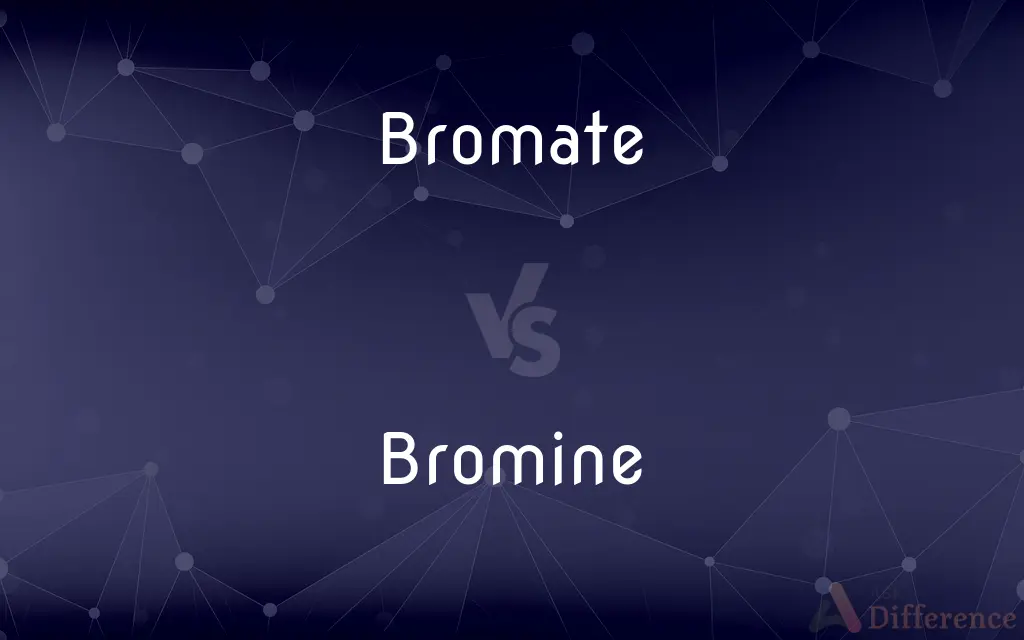Bromate vs. Bromine — What's the Difference?
By Tayyaba Rehman & Maham Liaqat — Updated on April 16, 2024
Bromate is an ion containing bromine and oxygen, used in chemical reactions, while bromine is a pure element, noted for its red-brown liquid form at room temperature.

Difference Between Bromate and Bromine
Table of Contents
ADVERTISEMENT
Key Differences
Bromate is a chemical compound derived from bromine; specifically, it is an ion that includes bromine and oxygen, usually appearing as part of salts like potassium bromate. Whereas bromine is a halogen element, existing in a diatomic form (Br2) and is one of the few elements that is liquid at room temperature.
In chemical formulations, bromate is often utilized for its oxidizing properties, especially in processes like strengthening dough in baking. On the other hand, bromine is used in a wider range of applications including as a flame retardant, in water purification, and in the manufacture of various brominated organic compounds.
Health and environmental impacts of bromate are significant; it is considered a potential carcinogen, leading to stringent regulations on its use and presence in foods and water. Bromine, while also hazardous, primarily poses risks of burns and respiratory problems due to its corrosive nature and volatility.
In terms of physical appearance, bromate compounds are typically white and crystalline when isolated, reflecting their ionic nature. Bromine, however, is distinctive with its deep red-brown color in liquid form, and a pungent odor that is easily recognizable.
Analytically, the presence of bromate in environmental samples is often monitored due to its health impacts, using techniques like ion chromatography. Bromine analysis, however, may involve methods like colorimetry or spectrophotometry, focusing on its elemental state and concentrations.
ADVERTISEMENT
Comparison Chart
Chemical Form
Ion (Bro₃⁻)
Diatomic molecule (Br₂)
Physical State
Typically part of white, crystalline compounds
Red-brown liquid at room temperature
Uses
Oxidizing agent in chemical synthesis and baking
Used in flame retardants, water treatment, medicines
Health Risks
Potential carcinogen
Causes burns and respiratory issues
Detection Methods
Ion chromatography
Colorimetry, spectrophotometry
Compare with Definitions
Bromate
A bromate is an oxyanion of bromine where bromine has an oxidation state of +5.
Potassium bromate is often added to flour to strengthen dough.
Bromine
Bromine is a chemical element with the symbol Br and atomic number 35.
Bromine is one of the only two elements that are liquid at room temperature.
Bromate
In environmental chemistry, bromates are monitored due to their health implications.
Drinking water standards strictly limit bromate concentrations.
Bromine
Bromine is also utilized in pharmaceuticals and photography.
Bromine-based compounds are crucial in the synthesis of certain drugs.
Bromate
As a chemical compound, bromates are known for their strong oxidizing properties.
Bromate is used in some hair treatments to help maintain the bond structure of hair.
Bromine
Bromine's volatility makes it a hazard in industrial settings.
Industries use rigorous containment measures to manage bromine safely.
Bromate
The term "bromate" can also refer to the process of treating with bromic acid or a bromate compound.
Bromate can be used to clean and disinfect pools.
Bromine
Highly corrosive and can burn the skin upon contact.
Handling bromine requires protective equipment due to its toxicity.
Bromate
Bromates can form as by-products in water treatment when bromine-containing waters are ozonated.
Water treatment plants test for bromate to ensure safety.
Bromine
Commonly used in the production of flame retardants due to its high reactivity.
Bromine compounds are added to furniture and electronics to prevent fires.
Bromate
The bromate anion, BrO−3, is a bromine-based oxoanion. A bromate is a chemical compound that contains this ion.
Bromine
Bromine is a chemical element with the symbol Br and atomic number 35. It is the third-lightest halogen, and is a fuming red-brown liquid at room temperature that evaporates readily to form a similarly coloured vapour.
Bromate
The inorganic polyatomic ion BrO3- or a compound containing it.
Bromine
A dense, volatile, corrosive, reddish-brown, nonmetallic liquid halogen element that exists as a diatomic molecule, Br2 having a highly irritating vapor. Chiefly isolated from brines, it is used in producing fumigants, dyes, water purification compounds, and photographic chemicals. Atomic weight 79.904; atomic number 35; melting point -7.2°C; boiling point 58.8°C; density of gas 7.59 grams per liter; specific gravity (liquid, at 20°C) 3.12; valence 1, 3, 5, 7. See Periodic Table.
Bromate
To treat (a substance) chemically with a bromate.
Bromine
(uncountable) A nonmetallic chemical element (symbol Br) with an atomic number of 35; one of the halogens, it is a fuming red-brown liquid at room temperature.
Bromate
(inorganic chemistry) the anion BrO3-1, derived from bromic acid; any salt containing this anion
Bromine
(countable) A bromine atom
Bromate
To treat with bromic acid or a bromate
Bromine
One of the halogen elements, related in its chemical qualities to chlorine and iodine. Atomic weight 79.8. Symbol Br. It is a deep reddish brown liquid of a very disagreeable odor, emitting a brownish vapor at the ordinary temperature. In combination it is found in minute quantities in sea water, and in many saline springs. It occurs also in the mineral bromyrite.
Bromate
A salt of bromic acid.
Bromine
A nonmetallic largely pentavalent heavy volatile corrosive dark brown liquid element belonging to the halogens; found in sea water
Bromate
To combine or impregnate with bromine; as, bromated camphor.
Bromate
React with bromine
Bromate
Treat with bromine
Common Curiosities
What are the safety concerns with bromine?
Bromine is corrosive and toxic, requiring careful handling to avoid burns and inhalation risks.
Why is bromine important in industries?
Bromine is vital for manufacturing flame retardants, water disinfectants, and various organic intermediates.
How are bromate and bromine detected in laboratories?
Bromate is typically detected through ion chromatography, while bromine concentrations can be measured using spectrophotometric methods.
Can bromate be naturally occurring?
Bromate can form naturally when bromide-containing waters are treated with ozone.
What is bromate used for?
Bromate is mainly used as an oxidizing agent in chemical syntheses and occasionally in baking.
Is there a connection between bromate and cancer?
Bromate has been classified as a potential carcinogen by health authorities due to evidence from animal studies.
How does bromine affect the environment?
Bromine compounds can accumulate in the environment, leading to potential ecological and health impacts.
What precautions are necessary when working with bromine?
Proper ventilation, protective clothing, and eye protection are essential when handling bromine.
How is bromate formed in drinking water?
Bromate can form during the ozonation of bromide-rich water sources.
Are bromates present in all types of flour?
Not all flours contain bromates; its use depends on regional food regulations and manufacturing processes.
What alternative chemicals are used instead of bromate in baking?
Alternatives such as ascorbic acid are used in place of bromate to strengthen dough without the associated health risks.
What products commonly contain bromine?
Electronics, clothing, furniture, and certain medications commonly contain bromine for its flame-retardant properties.
What regulations apply to bromate and bromine?
Both chemicals are regulated due to their health and environmental risks, with specific limits set for their presence in consumer products and emissions.
Can bromine be recycled in industrial processes?
Bromine recovery and recycling processes are established in some industries to reduce environmental impact.
How does bromine interact with other elements and compounds?
Bromine is highly reactive, forming various organic and inorganic bromine compounds used in many applications.
Share Your Discovery

Previous Comparison
Collateral vs. Lien
Next Comparison
Barrister vs. MagistrateAuthor Spotlight
Written by
Tayyaba RehmanTayyaba Rehman is a distinguished writer, currently serving as a primary contributor to askdifference.com. As a researcher in semantics and etymology, Tayyaba's passion for the complexity of languages and their distinctions has found a perfect home on the platform. Tayyaba delves into the intricacies of language, distinguishing between commonly confused words and phrases, thereby providing clarity for readers worldwide.
Co-written by
Maham Liaqat















































